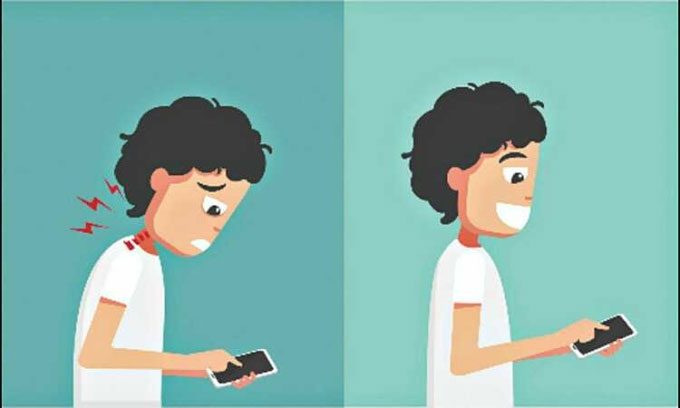Turtle Neck Syndrome (Text Neck Syndrome) refers to the condition of neck strain caused by technology devices, where the neck is held in a bent, forward-leaning position, adversely affecting health.
At the second Vietnam Scientific Conference on Physical Therapy held on June 16, experts from the Department of Rehabilitation Engineering at Hong Bang International University (Ho Chi Minh City) noted that in the turtle neck position, muscles and tissues suffer from damage due to repetitive stress when the neck is frequently bent forward, affecting the curvature of the cervical spine, muscles, and supporting ligaments, which can lead to early degeneration of the cervical spine in young individuals over time.
Commonly recognized symptoms include headaches, neck pain, shoulder and back pain, as well as tingling or numbness in the arms. Furthermore, spending hours looking at mobile phones with the neck extended forward for too long can elongate neck muscles and shorten chest muscles, which may increase pressure on the spine.
While turtle neck syndrome does not severely affect health and daily life, if not treated promptly, it can lead to serious complications such as limited mobility, respiratory and digestive issues, and aesthetic concerns…
There are many causes of turtle neck syndrome, among which the most common cause is improper standing and walking posture, with a slouched back and frequently swaying shoulders, excessive use of mobile phones, and an excessively low average neck angle. When the body is bent, pressure on the cervical spine increases. The more one tilts the head forward, the greater the weight that the cervical spine must bear from the head.
Experts state that with the widespread use of technology devices, this syndrome is affecting not only adults but also children. A research group at Hong Bang International University surveyed 425 students in Ho Chi Minh City, revealing that the incidence of turtle neck syndrome is 46.6%, meaning nearly 200 individuals are affected.

Turtle neck syndrome affects the curvature of the cervical spine, neck muscles, and shoulders. (Image: Spinesurgeonpune).
Turtle neck syndrome in children is very difficult to correct if not treated early. As a child’s spine grows, it becomes increasingly hard to adjust; children over 15 years old find it challenging to change posture compared to younger kids. If symptoms such as neck and shoulder pain or spinal health issues arise, it’s advisable to consult a doctor for physical therapy posture correction.
To prevent the condition, you should keep your phone at eye level (this posture is good for arm muscles) and position your computer screen high enough for you to look straight ahead rather than looking down. Try to maintain a posture where the spine forms a straight line from the top of the head to the tailbone. Limit prolonged screen time on computers or mobile phones.
If your job requires extensive computer use, make an effort to stand up and walk around every 20-30 minutes, and dedicate time outside of work for physical activities. Some exercises such as shoulder rotations and stretching will help mobilize neck muscles and reposition posture.




















































